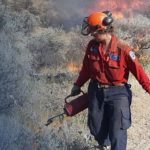Home »

Musical Bobolink gets around but faces threats
“It is as if he touched his harp with a vase of liquid melody, and when he lifted it out, the notes fell like bubbles from the strings…away he launches, and the meadow is all bespattered with melody.” – Henry David Thoreau on the song of the Bobolink.
If you stop by the Cranbrook irrigation fields at the eastern-most entrance from late May through July, and watch and listen, there’s a good chance you’ll hear and maybe see a Bobolink. They’re most active in early June when males are competing for mates and establishing nesting territories. Stand on the road alongside the emerging hay fields.
They’re unmistakable if you see one. Often said to look like they’re wearing a tuxedo backwards, Bobolinks are black with white wings and a pale yellow cap that looks like a hair-dye job gone badly awry. Their song, as noted by Thoreau, is a gurgling series of notes, also described by one biologist as “a bubbling delirium of ecstatic music.”
Apart from their magical song, you should marvel at the annual travels of Bobolinks.
They are one of the longest migrating songbirds. They spend our northern winters in the pampas grasslands and Patanal of southern Brazil, Paraguay and northern Argentina. This trans-equatorial migration means they are perpetually in a time of spring and summer. Yet they only breed here in North America. There does not appear to be enough daylight hours in their southern summer season (our winter) to trigger breeding physiology. The question of how they evolved such a lengthy migration remains unsolved.
 Their remarkable route takes them up through western South America, across the Caribbean Sea to the US Gulf Coast. From there, they fan out across eastern and central North America. Interior B.C. represents the limit of their northwestern range, some 10,000 km away from their “wintering” grounds!
Their remarkable route takes them up through western South America, across the Caribbean Sea to the US Gulf Coast. From there, they fan out across eastern and central North America. Interior B.C. represents the limit of their northwestern range, some 10,000 km away from their “wintering” grounds!
All migratory birds are an ecological wonder. Tiny feathered bodies, little more than a handful of song finding their way half-way around the world, across open seas, mountains and more. Bobolinks are thought to use a combination of stars and magnetism. Tissues around their nasal cavity contain iron oxide that likely aid in using the Earth’s magnetic field for orientation. But stars are also thought to play a key role in helping them find their way.
Originally adapted to breed in tall grass prairies across the North American Midwest, Bobolinks have readily switched to cultivation agriculture following European settlement. Most of their native tall grass prairie has been lost, but Bobolinks have taken to hay fields and similar habitats and spread both east and west of their original Midwest core habitat.
Many people are surprised to learn that Bobolinks nest directly on the ground. A fairly safe place to nest in the jungle of a tall grass prairie, it doesn’t work so well in hay fields that are harvested in early summer. Around about the time hay fields have a first pass with a swather, Bobolink nests are full of growing nestlings. This results in catastrophic loss of young. One study estimated that 321,000 eggs and nestlings are lost in Canada alone each year due to mowing.
How the Bobolinks at Cranbrook’s irrigation fields and other East Kootenay sites fair is not known, but prospects are likely grim. Still, enough birds seem survive to keep coming back over several generations and nesting in the same location each year.
In addition to this threat on their breeding grounds, Bobolinks are also persecuted in migration and on their winter grounds in South America. One of their weak spots is a love of rice – their scientific species name is oryzivorus, meaning “rice eater.” Large flocks descend on rice fields in southern US as well as Brazil and Argentina, much to the dismay of farmers. They are harassed, shot, captured and sold into pet trade.
Further threats come from pesticides both directly poisoning the birds themselves and reducing insect prey which forms the bulk of their diet on breeding grounds, especially food for young. Neonicotinoids that have been shown to decimate pollinators and birds are also a major concern.
Declines in Bobolink numbers in Canada have been significant, though more pronounced in eastern Canada than out west. Some of this decline may be a result of many farms in Ontario and Quebec being allowed to return to their pre-settlement forested habitats. Mostly, it is likely a result of early swathing of hay fields before Bobolink young have a chance to fledge their nest and escape.
When assessed as a possible species at risk, Canadian scientists found that between 1968 and 2008, Bobolinks declined at a rate of 5.2% per year with an overall loss of 88% of the population over the last 40 years. That was enough to be designated as a Threatened species and Bobolinks are now protected under the federal Species at Risk Act. Here in B.C., they are Blue Listed, meaning they are a species of concern and merit closer attention.
Solutions to the mowing threat are not difficult. If swathing can be delayed by as little as a week in some cases, survivorship of young increases greatly. The trick is finding the literal sweet spot of cutting hay at its peak nutritive value and when Bobolink nests have fledged.
If we can keep our fields alive with Bobolinks and “bespattered with melody,” our world will be a much better place. Given the incredible journey of the Bobolink, we should do no less.
Lead and above images: Bobolinks in the irrigation fields near Cranbrook. Photos courtesy Ian Adams
Ian Adams is a non-migratory wildlife biologist living near Cranbrook. He would, however, welcome the opportunity to visit Argentina’s pampas grasslands to check in on the Bobolinks.








